
During breast augmentation, an implant is surgically inserted under the breast tissues, and by this way, larger breasts than their original size can be achieved, but with a natural feel, shape, and behaviour. The operation (implantation) has been performed for more than 50 years and we have very significant experience to this day. The number of women wearing breast prostheses is tens of millions, and in recent years the number of implants being implanted has exceeded the order of millions.
The media is engaged in a silicone scandal during the years since it was broken out in 1992. Although the accusations never had been verified, the US’s authorities, which controls the food and medicament products/ FDA/ have bound to more rigorous terms for implanting silicone. Therefore American colleagues have applied saline filled implants until the first steps towards the abolishing of this prohibition have taken place in 2005. The community of plastic surgeons in most European countries never accepted the American opinion because the charges against the silicone implants could not be certified. The operations have continued, in Hungary as well. During the last years several hundred thousand check-ups were made. Statistical analysis of post-examinations of hundreds of thousands of patients has shown that intact, undamaged breast implants implanted during breast augmentation are not associated with any disease or damage to health. It has not been shown that a breast implant increases the risk of breast cancer, nor does the substance weaken the immune system or increase the chance of developing an autoimmune disease. It has not been shown that a silicone compound can be excreted in breast milk or that it is harmful to the fetus. In no case has a prosthesis previously implanted during breast augmentation been proven in the background of a disease affecting the whole body. The committee of EQUAM, which consists of plastic surgeons and other doctors from European countries, officially declares their stand points in the „CONSENSUS DECLARATUM” based on the analysis of check-ups made during the actual year. Of course, just as after any other operation there might occur complications, but these happen rarely, are local and cause no danger for health and generally with another opreation may be corrected. These will be discussed in more detail later.
Silicone implants manufactured today do not have a definite expiration date. So after implantation, if no other problem occurs, they can remain in place. Replacement, if later required for any reason, can be accomplished with a simple, non-stressful surgery. Pregnancy does not generate difficulties and neither does breast-feeding, but there may be exceptions. However, it is conceivable that after several births, the breasts will stretch, which would otherwise occur without a breast implant, but this condition can also be corrected with another surgery. A few months after the breast augmentation surgery all physical activities, even competitive sports, air travel, diving can be done, restrictions in later life can hardly occur.
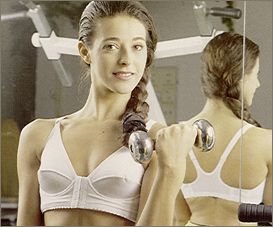
Tactile breast examination is important in the early diagnosis of breast cancer. The implants are placed behind the mammary gland so they do not disturb these checks. In some cases the mammography, which is X-ray examination of the breast, can not be evaluated, but there are modern image producing techniques /CT ,MRI, ultra-sound /and their results are better then that of mammography.
The final shape and size of the breasts develop only after puberty is completed, therefore it is not appropriate to perform the surgery before the age of 18 years. A significant number of interventions are needed after this age, when ladies realize their breasts are smaller and less developed than the average and there is no longer any hope for further growth /the complete absence of mammary gland is a literary rarity/. Young ladies sometimes also need this operation if their breasts have different shape or size. In this case, too, the implantation of one or both silicone implants are often part of the surgical correction. Another group of patients are women between the ages of 25 and 45, who have mental problems due to the regression of the glandular stock and the loosening of the breast after one or more births. There is no upper age limit, so a breast-enlarging operation can be done above the age of 50 years.
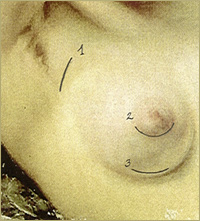 Although breast augmentation can also be performed under local anaesthesia, most of the time we choose general anaesthesia because it is more comfortable for the patient and in some ways safer. Before surgery, general health examination laboratory tests: blood, urine test, ECG are required. Breast ultrasound test and over 35 years of age also mammography test is needed.
Although breast augmentation can also be performed under local anaesthesia, most of the time we choose general anaesthesia because it is more comfortable for the patient and in some ways safer. Before surgery, general health examination laboratory tests: blood, urine test, ECG are required. Breast ultrasound test and over 35 years of age also mammography test is needed.
During breast augmentation, a breast implant can be inserted behind the tissues through a short incision of 3.8-4.5 cm. This can happen:
1. Underarm.
2. Around the edge of the nipple.
3. Under the breast at the breast cease (inframammary fold).
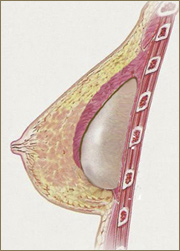
under the muscle
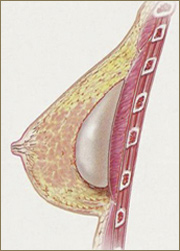
| under the mammary gland |
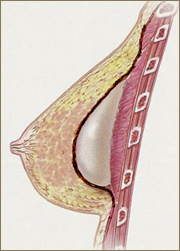
or under the membraine of the muscle
The material can be placed under the mammary gland or deeper, under the muscle of chest, or under the membraine of the muscle. All of the three have advantages and disadvantages, often the individual physique, lifestyle or the needs of the patient determine the method to be chosen.
The duration of the operation is 1-1,5 hours. During surgery, in some cases when surgical conditions necessitate, a thin tube is inserted in the area to lead out the tissue fluid leaking from the large wound area. The “drain pipe” together with the suction bottle attached to it forms a sterile closed system, which can reduce the likelihood of possible complications. This is usually removed the next day after surgery.
At the end of the operation, a bandage is placed on the operated area, which consists of a gauze pad located in the wound, a non-allergenic adhesive strip that fixes the shape, and a special tight bra made for this purpose.
Rest cure: Generally ladies spend one night at our clinic. Next morning they may go to their hotel. It is advisable to travel by car, but you should not drive at this time. Driving is possible no earlier than 4-5 days after surgery. After the operation, approx. 7-10 days of rest at home is required, mainly in bed besides the utmost care. All physical activity should be minimized, even wider arm movements should be avoided. After the 7th-10th days easier physical or mental work, sitting in an office is allowed. In the first two weeks, you need to come in for a wound check-up and a dressing change and on the 8-9. day the seams are removed.
Ache: The patient can expect a tense and blunt ache which is not unbearable and gradually decreases. Simple painkillers such as DEMALGON, ALGOPYRIN are effective. In the first two days slight fever might occur. Itching at the operated area in the 4th-5th days is the sign of healing. You should not sleep on your stomach for the first week, but you can already turn to the side.
Showering: The wound should not be exposed to water for 5 days. From the sixth day you can take a shower /not bath/. If clean or soapy water flows through the operated surface, it does not cause inflammation. After a short shower, the area around the wounds should be gently wiped with a freshly ironed clean towel, a sterile gauze pad placed on the wound, and the bra taken back.
Two weeks after the breast augmentation, the usual way of life can return, work can be resumed, and patients living abroad can travel home. For a few months, however, we still do not recommend intense sports, especially tennis, which requires wider arm movements, swimming, and exercise with more shaking, e.g. gymnastics, dance, aerobics, etc. For a few weeks, more caution is needed in sex life as well. Sunbathing, solarium for 4-5 weeks after surgery is not recommended. We propose using a sunbathing cream against the strong sunlights for six month after the operation. It is also important to wear a bra for another 2-3 months, but only during the day.
Implantable breast prostheses are manufactured by some large American and European companies, most of which also distribute their products in Hungary. They must, of course, have a mandatory CE certification in the European Union, which, among other things, guarantees the quality of healthcare products.
Nowadays, the outer cover of every implant is silicon-elastomer, but they contain different filling materials. Breast implants filled with silicone gel provide the tactile and behaviour most similar to the glandular tissue embedded in adipose tissue of a female breast. In the case of more modern implants, the microscopical leaking of silicon gel has been minimized by modifying the structure of the capsule. The gel structure has also changed, with gel-like cohesive gels prevalent. Saline-filled prostheses were used more frequently in the United States after silicone hysteria. Their disadvantage is that leakage of the solution is quite common, which can disturb the feel of the breast disturbingly. Implants filled with vegetable oil, the so named TRILUCENT implants are not used anymore because they have not been shown to be reliable. Similarly, hydrogel (aqueous gel) filled materials went out of the market due to the studies. Breast implants can also differ significantly in their wall structure. Initially, thin and smoother covers were made but later these were succeeded by thicker covers with more layers and even with double cavities. With the spread of rough surface materials over the last eight to ten years, a significant reduction in the occurrence of the previously common complication, the so-called capsular contracture, has been achieved. In addition, there are lens-shaped, low- or high-profile, and drop-shaped anatomical breast implants.
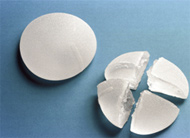
Cohesive silicon gel filled breast implant cut into four parts
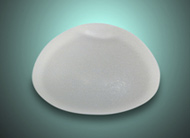
Silicon gel filled breast implant – round shape
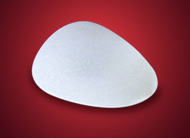
Silicon gel filled breast implant – drop shape
The most common complication associated with implanted material is capsular contracture. The implant is a tissue-friendly material, therefore is not ejected, but the human body demarcates it as a foreign substance, forming a thin connective tissue sheath around it. This capsule is already formed two to three weeks after implantation, but in most cases it does not cause a complaint, it is not felt. In some cases, however, the capsule thickens, shrinks, and can deform the breast implant, causes it to wrinkle, or move it out of place. Depending on the different degrees of severity of the process, the breast may become harder to the touch, deformed, and in more severe cases, a tense discomfort may occur. This complication does not become noticeable in the weeks immediately after surgery, it can cause complaints in months or even years. Its solution is possible with another operation, during which the pre-encapsulation state can be restored. The breast implant does not necessarily need to be replaced in this case. These complications were occurring, according to previous statistics, in the cases of 10-15%. Nowadays, only a few percent of patients undergo capsule surgery. The most possible reason of the decrease is the general use of roughened surface implants in the recent years. The implant can move or slip without capsule abnormality as well. Chances are 1-2 percent, infrequently, but you may need another surgery. A very rare complication is the cracking of the silicon wall. It might be caused by a serious injury, eg. a car accident. The filler can then get between the tissues. If it is saltwater, it absorbes without a trace, but the silicone gel does not cause any damage either if it is removed within a short time. In this case, it can be replaced with new implant. Very rarely, rupture of the silicone shell can occur spontaneously without external influence. Rippling may occur especially in patients with a thinner build or a disproportionately large implant that thins the breast tissue covering it.
Regardless of the implant, post-bleeding may occur with a 2-3% chance. Only a small part of the cases requires surgical emptying of the thus formed hematoma. The chances of inflammation are similar, and in some cases even without surgery / antibiotics, drain, etc. / it can be curable. However, if surgery is required, the material should be removed and re-implanted after a minimum of 2-3 months.
Generating of pathological cicatrice in the wound might occur in a few percentages. Often just that the wound healing is more protracted, the wound area is redder, and the scar is brighter and more compact. In such cases, improvement can be expected spontaneously, possibly the process can be accelerated with various creams, silicone sheets, injection into the scar is rarely necessary, and surgical scar correction is even less frequent. Sensory disturbance may occur in 4-5%, numbness and altered sensation may appear in the nipple or surrounding skin. Regeneration usually occurs spontaneously but can be long and can take up to a year.